The two types of speakers that can be utilized to install or improve your car’s sound system are coaxial and component. The coaxial speaker, commonly known as “full range,” is the most popular. It’s found in almost every OEM automotive radio system that leaves the factory. Multiple drivers are used in these speakers, allowing them to reproduce a wide variety of audio frequencies.
Component speakers are less popular, although audiophiles often use them to build high-end automobile audio systems. Because these speakers only have one driver, they can only create high, mid-range, or low tones.
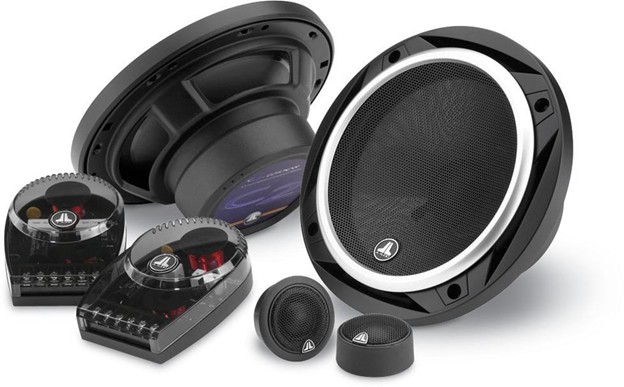
Interpretation
The following speaker terminology should be known in order to make an informed decision about purchasing and installing component and coaxial automobile speakers.
- Sound Sensitivity is a measurement of how loud speakers can be given the available power. The decibel rating is displayed.
- High and low frequencies are separated by Crossover filters and sent to different speakers.
- Tweeter drivers, often known as treble loudspeakers, are designed to create high-frequency sounds.
- Woofer drivers, which are substantially larger than tweeters, are used in bass loudspeakers to produce low-frequency sounds.
- Midrange drivers create sounds with a frequency in the center of the road.
- Frequency response is the range of tones that the speakers can handle, measured in hertz, that goes from treble to bass.
- The quantity of power required to deliver is described by the impedance rating.
- Peak Power Handling refers to a surge of power that may be sustained without causing wattage distortion.
- Root Mean Square Power (RMS) is a continuous power output in watts that is sustained without distortion. It is measured in ohms and is used to determine the best electrical signals.
Coaxial Speakers
Coaxial speakers are also known as “full-range speakers,” which is essentially the same thing. This is the most prevalent type of speaker, with coaxial speakers accounting for the majority of speakers on the market. You may have previously glanced at a few of them.
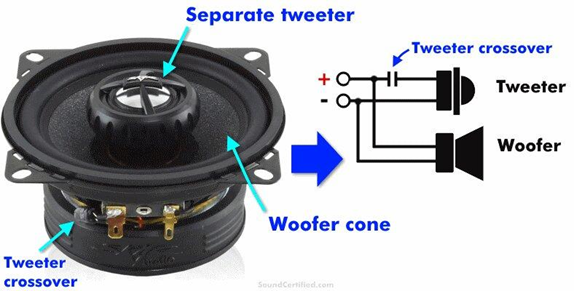
These speakers adhere to a size standard, making them simple to purchase and install. Simply measure the size of your present speakers and purchase speakers that are the same size. A coaxial speaker has a woofer in the middle and a tweeter in the center; thus, it can handle all frequencies.
The default sound system package that comes with your new automobile usually includes coaxial speakers. Coaxials are smaller than components because the drivers are in the same speaker. If you purchase an improved sound system, you will almost certainly have the option of adding component speakers for an additional fee.
PROS of Coaxial Speaker System
- They’re a drop-in replacement for older factory-installed single-cone speakers that sound terrible.
- Buyers can choose from a variety of performance and price alternatives, including varying levels of tweeter quality, crossover design, cone materials, and higher power ratings.
- They provide performance comparable to separate 2-way component car speakers, but without the need to install a separate speaker crossover.
- They’re easy to come by and really popular – in fact, they’re the most common automobile speaker upgrade, and they’re very easy to come by while shopping.
- Affordability: Excellent coaxial car speakers may be had for as little as $25; coaxials of excellent quality cost around $50-$65.
- Many people’s older speakers have poor frequency response, which can be easily fixed with coaxial speakers.
A tweeter, a woofer, and a simple crossover are all incorporated into a single speaker assembly in coaxial speakers. Unlike cheaper single-cone speakers, most have a woofer cone with a separate tweeter for good full-range sound quality and frequency coverage.

2-Way or 3-Way Coaxial Car Speakers?
3-way coaxial speakers are essentially 2-way variants with an additional tiny speaker (typically another tweeter or a sort of midrange) added for improved sound quality.
It’s critical to remember that, just because they appear nicer, they don’t necessarily sound better than a solid 2-way model. However, some offer noticeably better sound quality.
Some 3-way full-range speakers, for example, include a tiny piezo-type tweeter that can go beyond the upper frequency limit of regular tweeters, resulting in improved sound. Not only do the best models have a wider variety of sound frequencies, but they also have a nearly flat sound response, which is excellent.
The major takeaway is that a high-quality, well-designed 2-way speaker can produce excellent sound and is, in most cases, your best value for money. Don’t waste your time, effort, and money on 3-way speakers because you think they’re better because of the extra speaker.

It all boils down to the quality and design elements, as it does with so many other things. I propose focusing your search on a high-quality 2-way coaxial speaker system.
Component Speakers
Component speakers give higher sound quality by using separate speakers and a more complex crossover. They’re a step up from coaxial speakers and provide greater sound. Component speakers, which consist of a woofer, tweeter, and crossover that are all installed independently, are a more complex speaker system that produces greater sound quality than coaxial speakers.
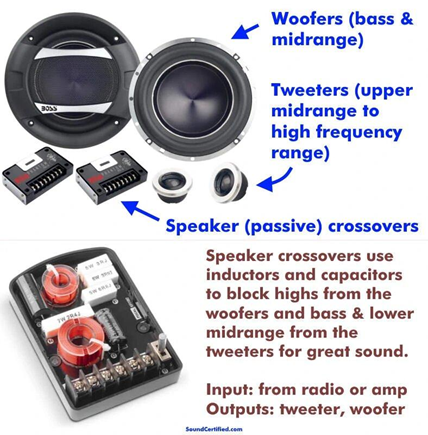
Component speakers, for example, frequently use superior dome tweeters and woofer materials, as well as a more modern (and better) speaker crossover. Additional wiring configurations, as well as a tweeter volume reduction option and tweeter fusing to prevent overload, may be included.
Some are even designed to be put together in the shape of coaxial speakers to make installation easier.
Advantages of Component Speakers
- Better overall frequency response and sound accuracy — even entry-level component speaker setups may provide fantastic sound!
- Silk, aluminum, ceramic, or other specific dome materials are prevalent in tweeters with a stiffer and high-performance construction.
- More power handling — typically 75 watts RMS, 100 watts RMS, or even higher.
- In comparison to the conventional -6dB/octave crossover used on coaxial tweeters, -12dB per octave crossover slopes (or larger) are employed.
- Better quality crossover components.
- Speaker connector terminals and installation accessories that are better.
- The ability to position the tweeters for greater stereo imaging during music playback at a line-of-sight listening angle and height.
Differences between coaxial and component speaker crossovers
In most coaxial speakers, a basic high-pass crossover is used just for the tweeter to block bass, and no crossover is used for the woofer. Overall, the sound is good, but there is space for development.
Component speakers, on the other hand, employ a more sophisticated crossover that prevents undesired sound frequencies from reaching the woofer or tweeter. Less distortion, more accurate sound, and a better listening experience are the end results.
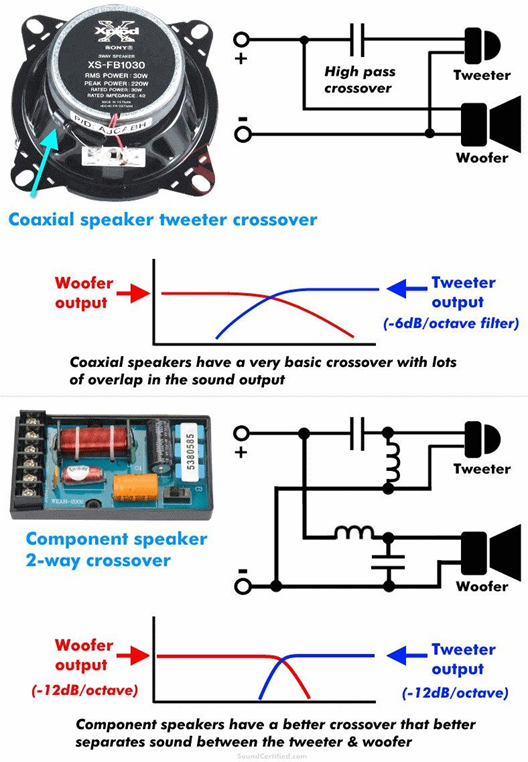
Connection/Wiring Difference between Component & Coaxial Speakers
Here’s a quick rundown of the necessary electrical connections
Coaxial Speaker System
- Coaxial speakers are similar to factory-installed speakers in that the positive and negative wires from the head unit or amplifier are connected to the same terminals on the speaker.
- Note: You may need to run new speaker wire to avoid the bothersome old wiring when replacing some factory-installed “premium” speaker systems.
Component Speaker System
- The INPUTS of the speaker crossover are connected to the speaker outputs of the head unit or amplifier.
- Connect the tweeter’s positive and negative terminals to the crossover’s tweeter output.
- Connect the positive and negative terminals of the woofer to the crossover’s woofer output.
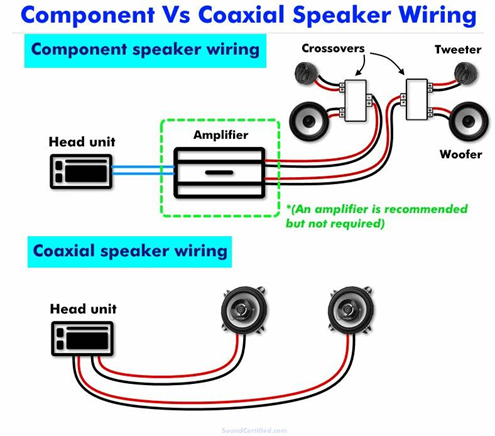
Amplifier Requirement
When it comes to driving components or coaxial speakers, employing an amplifier has a lot of benefits. Here are some reasons why you should consider boosting your speakers:
- There is less distortion, and the sound is clearer.
- The ability to use a crossover to block power-robbing and distorting low-end bass.
- There’s plenty of power to go around for a lot more loudness.
- There’s a lot more versatility when it comes to setting up the system.
Are Component Speakers better than Coaxial Speakers?
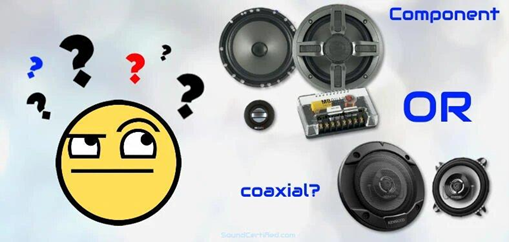
Component speakers, as previously stated, use more advanced crossovers than coaxial speakers. They filter in two stages rather than the single one employed by coaxials. This means that the tweeter can filter out more bass and midrange sound, while the woofer can block out more high-frequency sound. Check out the Infinity Reference 6530cx component Speaker system.
In most coaxials, the tweeter is connected to a single inexpensive capacitor, but the woofer is not. Instead, they adopt a low-cost design that takes use of the fact that most woofers inherently “roll off” (stop generating) higher frequencies. Check out the Kicker 43dsc650 Coaxial Speaker system
Although it gets the job done and functions, there is still room for development, and the sound quality suffers as a result.
What factors should you think about while deciding whether to use coaxials or components?
Top Notch Sound Quality
- This is one of the disadvantages of coaxial speakers, which is why component speakers win hands down in this category.
- Separate drivers for different frequencies in the spectrum are used in component speakers, resulting in a much cleaner sound.
- You have woofers for bass, tweeters for high frequencies, and midrange components for everything in between.
- Furthermore, component speakers perform exceptionally well in terms of imagery.
- This is primarily due to the ability to place tweeters at ear level, giving the impression that the music is emanating from your dashboard. This is a wonderful experience that contributes significantly to sound quality.
- Coaxial speakers, on the other hand, have a major drawback: their image is terrible.
- This isn’t simply true for one model, but for all of them, and it’s a weakness in the design.
- Frequency interference occurs because the drivers for various frequency spectrums are too close to each other.
Customization
- Component speakers also take the cake when it comes to customization, adaptability, and the general amount of things you can do with them.
- This is especially true if you want a personalized audio system, as component speakers allow you to place things where and how you want them to get the desired sound impact.
- A typical component speaker system, for example, includes two woofers, two tweeters, and two crossovers.
- If you want a little more punch in the mid frequencies, you may add extra midrange drivers, or go for super-tweeters for superior sound quality at the high end.
- You have complete control over how things are set up with this. On-axis response is achieved by positioning the speakers so that they face the listener.
- This puts the sound “in your face” and improves higher frequency reproduction.
- If you turn them away from the listener, on the other hand, you’ll get better off-axis response and bass. If you’ve ever wondered why a subwoofer sounds better when it’s placed behind you, this is the explanation
Pricing
- The price should be the last thing on your mind. You get a lot of bang for your money with coaxial speakers, and they’re frequently less expensive. The fact that they’re designed to save space, time, and money in the first place helps a lot.
- Component speakers, on the other hand, take a lot longer to produce and require a lot more materials, which is a cost passed on to the user. This is why, in most circumstances, they are more expensive than coaxials.
Speakers that are simpler to set up
- We’ve arrived at the point when your contribution is required. How competent are you at installing automobile audio equipment? If you want to take advantage of all the benefits of component speakers, you’ll either need to have solid technical skills or be willing to pay for installation.
- You can locate components that make it simple to put the tweeter in the woofer’s center, making installation less of a hassle. However, if you want to mount drivers in various locations, you’ll need a lot of installation expertise.
- Installation is straightforward and quick with coaxial speakers. When you have the necessary tools, you can install these speakers in a matter of minutes. In contrast to components, where you must manage three connections and three sets of speaker wires, you simply have one input connected to the handle.
Type of Vehicle you have
- Remember that your car has a say in the selection process as well. The majority of coaxial speakers are made to fit into the gaps left by existing OEM or factory speakers. One of the main reasons why coaxial speakers are more frequent than component speakers is because of this.
- Because of their space and installation restrictions, component speakers may not fit all automobile models. You’ll need to conduct additional research ahead of time to figure out which component speakers are compatible with your vehicle.
Coaxial speakers are the way to go if
- You don’t have a lot of money to spend, or you just need something that sounds decent but isn’t “high end.”
- You’re looking for a simple approach to replace your aging speakers.
- You don’t intend to employ amplification for your speakers and will instead rely on a conventional stereo.
- You don’t want to put in the extra effort or run the extra wire that component speakers require.
- You don’t have the time, resources, or financial means to invest in a custom installation.
Component speakers are the way to go if
- You’re primarily concerned with sound quality.
- You would like to use speakers that have more advanced materials? (especially for the tweeters).
- You prefer speaker crossovers with a sharper cutoff and/or the ability to reduce the loudness of the tweeter.
- You will be installing higher-end electronics in a custom home, automobile stereo, or marine speaker installation.
- For music playing and critical listening with high-fidelity recordings, you want better stereo imaging.
- For added power and clarity, you’d like to use an amplifier to drive your speakers.
Bottom Line: Are Component Speakers Better?
Both have advantages and disadvantages, as you’ve just read, but the component speaker will deliver superior, distortion-free loud music at a wider and clearer frequency range. Although there are some outstanding coaxial speakers available, they will not sound as nice as the best component speakers.
Keep in mind that once components are mounted in a car, they have a significant stereo-imaging advantage. Mounting the tweeters closer to your ear level makes it appear as if the music is coming from your dash, rather than down in your doors.

